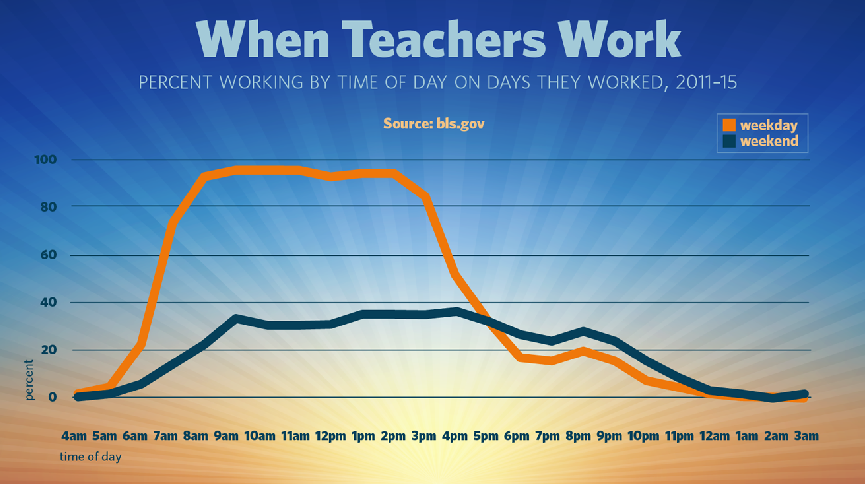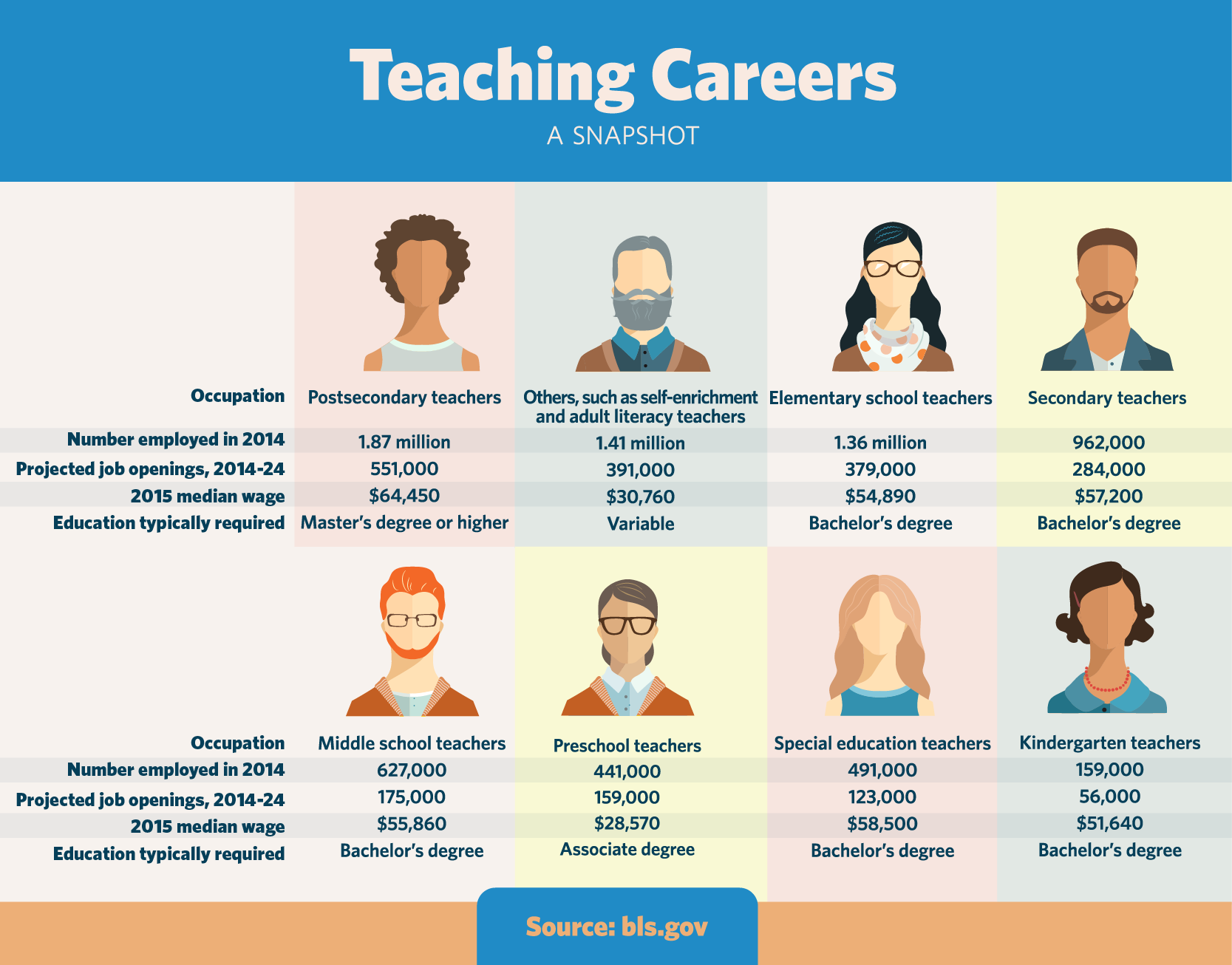Editor’s note: The following has been cross-posted from the U.S. Department of Labor blog. The writer is Allen Chen, an economist at the U.S. Bureau of Labor Statistics. This blog post was adapted from a Career Outlook article by Dennis Vilorio, an economist formerly employed by BLS.
If you dream of inspiring the minds of the future, consider teaching. Teachers give students the knowledge and tools to succeed both in school and beyond the classroom. It’s a smart career choice, too: Most teaching jobs pay above the median for all occupations ($36,200), and BLS projects there will be more than 2 million job openings between 2014 and 2024 for teachers at all levels.
Types of teachers
- Preschool and K-12 teachers: These teachers are often generalists in lower grades but specialize in certain subjects in higher grades.
- Postsecondary teachers: Commonly referred to as professors or instructors, these teachers work in community colleges, universities, technical and trade schools, and other institutions of higher learning. Besides instructing students, they conduct research and publish academic papers and books.
- Special education and other teachers: These teachers work with children and adult students who have special needs, who want remedial help, or who need literacy instruction.
A day in the life
Teachers might be envied for the summer and holiday breaks they get, but the data show that they put in long hours preparing for their students. Many work on the weekends and outside the classroom after school by sponsoring student clubs or chaperoning events.
Some teachers are with the same students all day; others have a few classes throughout the day with different students. Many teachers say that challenges with classroom management, workload, and bureaucratic oversight are the most frustrating elements of the job. But they say the most satisfying parts are watching students learn, the variety each day brings, and working with supportive colleagues.

Editor’s note: A text-only version of the graphic is below. The data are restricted to days that people who described their main job as being a teacher and reported doing at least one minute of work for their main job. Holidays are excluded from the data.
By the numbers
BLS data show variation in employment, projected job openings, and wages among teaching occupations. Wages also vary based on grade level and geographic location, but nearly all teaching jobs had median annual wages that were higher than the $36,200 median annual wage for all occupations in May 2015.

Editor’s note: A text-only version of the graphic is below. Job openings are from employment growth and the need to replace workers who leave the occupation. The “other” category includes adult basic and secondary education and literacy teachers and instructors, self-enrichment education teachers, and miscellaneous teachers and instructors.
Becoming a teacher
Before leading your own classroom, you’ll have to learn to be a teacher. The skills, education, and other qualifications to be eligible vary widely — one good resource for finding requirements in your state is teacher.org.
For example, preschool teachers typically must have an associate’s degree, kindergarten through secondary teachers usually require a bachelor’s degree, and postsecondary teachers generally need a doctoral degree or a master’s degree in their field. None of the occupations typically require work experience in a related occupation for entry-level employment, but an internship or residency may be necessary as part of on-the-job training. And teachers in public schools usually need certification or a license.
There are plenty of ways to help shape the future, one mind at a time. Which path will you choose?
Learn more: More information about teaching or teaching-related occupations is available in the Occupational Outlook Handbook, as well as from the U.S. Department of Education and professional teaching associations. You might also qualify for loan forgiveness or for taking an alternative route to becoming teacher if you commit to work in a low-income community.
Graphic 1: What Time Teachers Work
| Percent of teachers working, by time of day on days they worked, 2011–15 | ||
| Time of day | Weekday | Weekend day |
| 4-4:59 am | 1.2 | 1.1 |
| 5-5:59 am | 4.3 | 1.1 |
| 6-6:59 am | 21.6 | 5.5 |
| 7-7:59 am | 69.6 | 13.6 |
| 8-8:59 am | 88.1 | 20.6 |
| 9-9:59 am | 90.7 | 31.1 |
| 10-10:59 am | 91.0 | 28.6 |
| 11-11:59am | 91.2 | 29.7 |
| 12-12:59 pm | 88.1 | 28.9 |
| 1-1:59 pm | 89.1 | 33.2 |
| 2-2:59 pm | 89.7 | 32.8 |
| 3-3:59 pm | 80.0 | 32.4 |
| 4-4:59 pm | 47.9 | 34.4 |
| 5-5:59 pm | 30.1 | 30.8 |
| 6-6:59 pm | 16.0 | 25.5 |
| 7-7:59 pm | 15.0 | 22.9 |
| 8-8:59 pm | 18.2 | 27.4 |
| 9-9:59 pm | 14.3 | 23.4 |
| 10-10:59 pm | 7.2 | 14.0 |
| 11-11:59 pm | 3.6 | 8.0 |
| 12-12:59 am | 2.0 | 2.5 |
| 1-1:59 am | 0.4 | 1.1 |
| 2-2:59am | 0.3 | 0.7 |
| 3-3:59 am | 0.3 | 0.9 |
Graphic 2: Types of Teaching Occupations
| Occupation | Number employed in 2014 | Projected job openings, 2014-24 | 2015 median wages | Typical education needed for entry |
| Postsecondary teachers | 1,869,400 | 550,600 | $64,450 | Master’s degree or higher |
| Others, such as self-enrichment and adult literacy teachers | 1,408,700 | 391,000 | $30,760 | Variable |
| Elementary school teachers | 1,358,000 | 378,700 | $54,890 | Bachelor’s degree |
| Secondary school teachers | 961,600 | 284,000 | $57,200 | Bachelor’s degree |
| Middle school teachers | 627,500 | 175,500 | $55,860 | Bachelor’s degree |
| Preschool teachers | 441,000 | 158,700 | $28,570 | Associate degree |
| Special education teachers | 491,100 | 123,500 | $58,500 | Bachelor’s degree |
| Kindergarten teachers | 159,400 | 56,100 | $51,640 | Bachelor’s degree |
 United States Department of Labor
United States Department of Labor